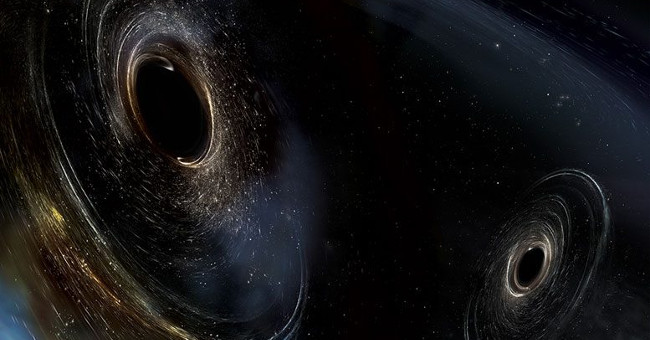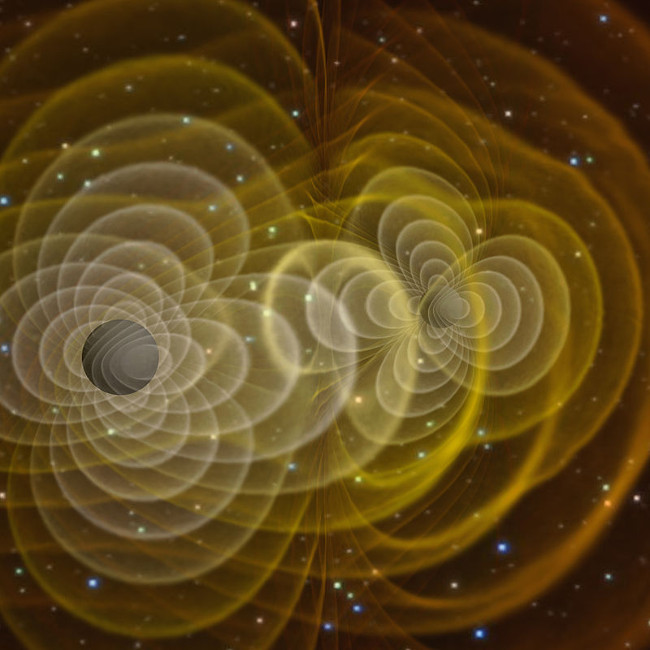Discovering new gravitational waves from two black holes collides 3 billion light-years away
New gravitational wave signals are produced when two black holes are 3 billion light-years away facing each other and eventually merging into a new one discovered by German scientists in the early morning of January 4.
- Discover the terrible war between two giant black holes in the universe
- Gravitational waves can be the key to revealing the existence of another dimension in the universe
 Discovering new gravitational waves from two black holes collides 3 billion light-years away Picture 1
Discovering new gravitational waves from two black holes collides 3 billion light-years away Picture 1
Graphic of two merged black holes.(Photo: LIGO)
Scientists at the Interfering Laser Wave Observatory (LIGO) have recorded a new gravitational signal called GW170104, which came from the merger of two black holes 3 billion light-years from Earth. This gravitational wave signal is far more distant than the two gravitational wave signals that LIGO once discovered.
Scientists have discovered phenomena like black holes merged by studying distortions in space and time.
The two black holes in the collision had masses of 31.2 and 19.4, respectively. After the collision, a new, heavy black hole equivalent to 48.7 Sun, was born. The lost mass is converted into gravitational waves.
Compared to the black hole formed by the previous two mergers that scientists have observed, this newly formed black hole is considered to have medium mass. According to scientists, mid-range black holes are gradually gaining popularity in the universe.
The majority of black holes are born from a dead star, which is considerably lighter in weight than the newly created black hole this time. At the center of the galaxies, there are a number of super-large black holes, weighing millions to billions of solar masses.
The gravitational wave signal from the merger has just been discovered that two black holes do not rotate on the same axis, they are only paralleled at the end of the life cycle.
 Discovering new gravitational waves from two black holes collides 3 billion light-years away Picture 2
Discovering new gravitational waves from two black holes collides 3 billion light-years away Picture 2
Attractive wave image, announced by Advanced LIGO directly and announced on 11/2/2016.
From more than a century ago, in 1916 Einstein had predicted the existence of gravitational waves and assumed that it was not scattered like light.
Upon discovering this gravitational wave, scientists will study the possibility of scattering gravitational waves to determine the limit in Albert Einstein's theory of relativity. LIGO's measurements have not been in conflict with Einstein's conclusions.
At the same time, the discovery of this new gravitational wave also indicates the diversity of black holes in the universe. Accordingly, in the future LIGO will conduct systematic studies of black holes in the universe instead of the single phenomenon studies as before.
You should read it
- 10 interesting facts about black holes in the universe (Part 1)
- Discover the terrible war between two giant black holes in the universe
- For the first time in history, people witnessed two merged neutron stars creating gravitational waves
- A new discovery about the strange interaction between cosmic black holes and light
- Find out how to weigh black holes based on galaxy spiral arms
- Successfully creating cosmic black holes, demonstrating Hawking radiation exists
- Detecting monstrous black holes, 20 billion times larger than the sun and growing 'fast'
- Discover the most bizarre black holes in the mysterious space universe
- Journey to find gravitational waves and unprecedented world discoveries
- The discovery of a giant black hole, 70 times the mass of the Sun in the Milky Way, challenges every theory
- Our galaxy contains countless invisible black holes?
- 10 interesting facts about black holes in the universe (Part 2)
May be interested

40 interesting facts you didn't know about the Sun.

How fast can a rocket fly to win gravity and escape the Earth?

Detects the hottest outer planet in the universe, with temperatures up to 4,327 ° C

What 'terrible' will happen if the Earth suddenly stops spinning?

Did you know: Mars, Venus has rotten egg smell and the Moon smells of gunpowder

Strange worms grow 2 heads when living for 5 weeks in the universe





 For the first time in history, people witnessed two merged neutron stars creating gravitational waves
For the first time in history, people witnessed two merged neutron stars creating gravitational waves Discover the terrible war between two giant black holes in the universe
Discover the terrible war between two giant black holes in the universe Detecting monstrous black holes, 20 billion times larger than the sun and growing 'fast'
Detecting monstrous black holes, 20 billion times larger than the sun and growing 'fast' A new discovery about the strange interaction between cosmic black holes and light
A new discovery about the strange interaction between cosmic black holes and light 10 interesting facts about black holes in the universe (Part 1)
10 interesting facts about black holes in the universe (Part 1) Journey to find gravitational waves and unprecedented world discoveries
Journey to find gravitational waves and unprecedented world discoveries